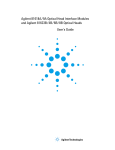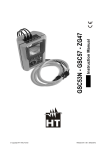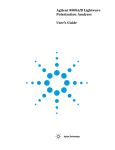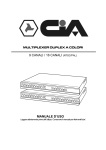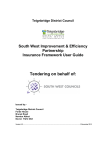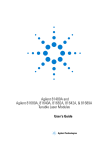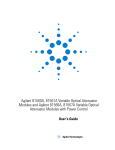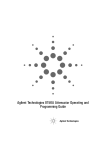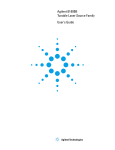Download Agilent Technologies N3970A Technical data
Transcript
cleaning.book Page 1 Wednesday, May 22, 2002 5:16 PM Cleaning Procedures for Lightwave Test and Measurement Equipment Pocket Guide Agilent Technologies cleaning.book Page 2 Wednesday, May 22, 2002 5:16 PM Notices © 2002 Agilent Technologies, Inc. No part of this manual may be reproduced in any form or by any means (including electronic storage and retrieval or translation into a foreign language) without prior agreement and written consent from Agilent Technologies, Inc. as governed by United States and international copyright laws. Manual Part Number N3900-90A5J1 Edition First Edition, May 2002 Printed in Germany Agilent Technologies Deutschland GmbH Herrenberger Str. 130 71034 Boeblingen Germany Warranty The material contained in this document is provided “as is,” and is subject to being changed without notice in future editions. Further, to the maximum extent permitted by applicable law, Agilent Technologies disclaims all warranties of merchantability and fitness for a particular purpose. Agilent Technologies shall not be liable for errors or for incidental or consequential damages in connection with the furnishing, use, or performance of this document or of any of the products to which it pertains. Should Agilent Technologies have a written contract with the user and should any of the contract terms conflict with these tersm the contract terms shall control. Technology Licenses The hardware and/or software described in this document are furnished under a license and may be used or copied only in accordance with the terms of such license. Restricted Rights Legend If software is for use in the performance of a U.S. Government prime contract or subcontract, Software is delivered and licensed as “Commercial computer software” as defined in DFAR 252.227-7014 (June 1995), or as a “commercial item” as defined in FAR 2.101(a) or as “Restricted computer software” as defined in FAR 52.227-19 (June 1987) or any equivalent agency regulation or contract clause. Use, duplication or disclosure of Software is subject to Agilent Technologies’ standard commercial license terms, and non-DOD Departments and Agencies of the U.S. Government will receive no greater than Restricted Rights as defined in FAR 52.227-19(c)(1-2) (June 1987). U.S. Government users will receive no greater than Limited Rights as defined in FAR 52.227-14 (June 1987) or DFAR 252.227-7015 (b)(2) (November 1995), as applicable in any technical data. 2 cleaning.book Page 3 Wednesday, May 22, 2002 5:16 PM WA R NI NG CA U TI ON 3 A WARNING notice denotes a hazard. It calls attention to an operating procedure, practice, or the like that, if not correctly performed or adhered to, could result in personal injury or death. Do not proceed beyond a WARNING notice until the indicated conditions are fully understood and met. A CAUTION notice denotes a hazard. It calls attention to an operating procedure, practice, or the like that, if not correctly performed or adhered to, could result in damage to the product or loss of important data. Do not proceed beyond a CAUTION notice until the indicated conditions are fully understood and met. cleaning.book Page 4 Wednesday, May 22, 2002 5:16 PM 4 cleaning.book Page 5 Wednesday, May 22, 2002 5:16 PM Cleaning Procedures for Lightwave Test and Measurement Equipment Pocket Guide 1 Cleaning Procedures for Lightwave Test and Measurement Equipment Safety Precautions 6 Agilent Technologies 5 cleaning.book Page 6 Wednesday, May 22, 2002 5:16 PM 1 Cleaning Procedures for Lightwave Test and Measurement Safety Precautions The following Cleaning Instructions contain some general safety precautions, which must be observed during all phases of cleaning. Consult your specific optical device manuals or guides for full information on safety matters. Please try, whenever possible, to use physically contacting connectors, and dry connections. Clean the connectors, interfaces, and bushings carefully after use. If you are unsure of the correct cleaning procedure for your optical device, we recommend that you first try cleaning a dummy or test device. Agilent Technologies assumes no liability for the customer's failure to comply with these requirements. NOT E Please follow the following safety rules. Do not remove instrument covers when operating. Ensure that the instrument is switched off throughout the cleaning procedures. Use of controls or adjustments or performance of procedures other than those specified may result in hazardous radiation exposure. Make sure that you disable all sources when you are cleaning any optical interfaces. Under no circumstances look into the end of an optical device attached to optical outputs when the device is operational. The laser radiation is not visible to the human eye, but it can seriously damage your eyesight. To prevent electrical shock, disconnect the instrument from the mains before cleaning. Use a dry cloth, or one slightly dampened with water, to clean the external case parts. Do not attempt to clean internally. Do not install parts or perform any unauthorized modification to optical devices. Refer servicing only to qualified and authorized personnel. 6 Cleaning Procedures cleaning.book Page 7 Wednesday, May 22, 2002 5:16 PM Cleaning Procedures for Lightwave Test and Measurement Cleaning Procedures 7 cleaning.book Page 8 Wednesday, May 22, 2002 5:16 PM 1 8 Cleaning Procedures for Lightwave Test and Measurement Cleaning Procedures cleaning.book Page 9 Wednesday, May 22, 2002 5:16 PM Cleaning Procedures for Lightwave Test and Measurement Equipment Pocket Guide 2 Why is it important to clean optical devices ? In transmission links optical fiber cores are about 9 µm (0.00035”) in diameter. Dust and other particles, however, can range from tenths to hundredths of microns in diameter. Their comparative size means that they can cover a part of the end of a fiber core, and thus degrade the transmission quality. This will reduce the performance of your system. Furthermore, the power density may burn dust into the fiber and cause additional damage (for example, 0 dBm optical power in a single mode fiber causes a power density of approximately 16 million W/m2). If this happens, measurements become inaccurate and non-repeatable. Cleaning is, therefore, an essential yet difficult task. Unfortunately, when comparing most published cleaning recommendations, you will discover that they contain several inconsistencies. In this pocket guide, we want to suggest ways to help you clean your various optical devices, and thus significantly improve the accuracy and repeatability of your lightwave measurements. Agilent Technologies 9 cleaning.book Page 10 Wednesday, May 22, 2002 5:16 PM 2 10 Why is it important to clean optical devices ? Cleaning Procedures cleaning.book Page 11 Wednesday, May 22, 2002 5:16 PM Cleaning Procedures for Lightwave Test and Measurement Equipment Pocket Guide 3 What materials do I need for proper cleaning? Standard Cleaning Equipment on page 12 Additional Cleaning Equipment on page 16 Agilent Technologies 11 cleaning.book Page 12 Wednesday, May 22, 2002 5:16 PM 3 What materials do I need for proper cleaning? Standard Cleaning Equipment Before you can start your cleaning procedure you need the following standard equipment: • Dust and shutter caps • Isopropyl alcohol • Cotton swabs • Soft tissues • Pipe cleaner • Compressed air Dust and shutter caps All Agilent Technologies lightwave instruments are delivered with either laser shutter caps or dust caps on the lightwave adapter. Any cables come with covers to protect the cable ends from damage or contamination. We suggest these protective coverings should be kept on the equipment at all times, except when your optical device is in use. Be careful when replacing dust caps after use. Do not press the bottom of the cap onto the fiber too hard, as any dust in the cap can scratch or pollute your fiber surface. If you need further dust caps, please contact your nearest Agilent Technologies sales office (see “Agilent Service and Support” on page 48). Isopropyl alcohol This solvent is usually available from any local pharmaceutical supplier or chemist’s shop. Results will vary depending on the purity of the alcohol. If you use isopropyl alcohol to clean your optical device, do not immediately dry the surface with compressed air (except when you are cleaning very sensitive optical devices). This is because some of the dust and the dirt is dissolved in the alcohol and will leave behind filmy deposits after 12 Cleaning Procedures cleaning.book Page 13 Wednesday, May 22, 2002 5:16 PM What materials do I need for proper cleaning? 3 the alcohol is evaporated. You should therefore first remove the alcohol and the dust with a soft tissue, and then use compressed air to blow away any remaining filaments. If possible avoid using denatured alcohol containing additives. Instead, apply alcohol used for medical purposes. Never drink this alcohol, as it may seriously damage your health. Do not use any other solvents, as some may damage plastic materials and claddings. Acetone, for example, will dissolve the epoxy used with fiber optic connectors. To avoid damage, only use isopropyl alcohol. Cotton swabs We recommend that you use swabs such as Q-tips or other cotton swabs normally available from local distributors of medical and hygiene products (for example, a supermarket or a chemist’s shop). You may be able to obtain various sizes of swab. If this is the case, select the smallest size for your smallest devices. Ensure that you use natural cotton swabs. Some foam swabs will often leave behind filmy deposits after cleaning. Use care when cleaning, and avoid pressing too hard onto your optical device with the swab. Too much pressure may scratch the surface, and could cause your device to become misaligned. It is advisable to rub gently over the surface using only a small circular movement. Swabs should be used straight out of the packet, and never used twice. This is because dust and dirt in the atmosphere, or from a first cleaning, may collect on your swab and scratch the surface of your optical device. Soft tissues These are available from most stores and distributors of medical and hygiene products such as supermarkets or chemists shops. Cleaning Procedures 13 cleaning.book Page 14 Wednesday, May 22, 2002 5:16 PM 3 What materials do I need for proper cleaning? We recommend that you do not use normal cotton tissues, but multi-layered soft tissues made from non-recycled cellulose. Cellulose tissues are very absorbent and softer. Consequently, they will not scratch the surface of your device over time. Use care when cleaning, and avoid pressing on your optical device with the tissue. Pressing too hard may lead to scratches on the surface or misalignment of your device. Just rub gently over the surface using a small circular movement. Use only clean, fresh soft tissues and never apply them twice. Any dust and dirt from the air which collects on your tissue, or which has gathered after initial cleaning, may scratch and pollute your optical device. Pipe cleaner Pipe cleaners can be purchased from tobacconists, and come in various shapes and sizes. The most suitable one to select for cleaning purposes has soft bristles, which will not produce scratches. The best way to use a pipe cleaner is to push it in and out of the device opening (for example, when cleaning an interface). While you are cleaning, you should slowly rotate the pipe cleaner. Only use pipe cleaners on connector interfaces or on feedthrough adapters. Do not use them on optical head adapters, as the center of a pipe cleaner is hard metal and can damage the bottom of the adapter. Your pipe cleaner should be new when you use it. If it has collected any dust or dirt, this can scratch or contaminate your device. The tip and center of the pipe cleaner are made of metal. Avoid accidentally pressing these metal parts against the inside of the device, as this can cause scratches. Dry stick cleaner Compressed air Compressed air can be purchased from any laboratory supplier. 14 Cleaning Procedures cleaning.book Page 15 Wednesday, May 22, 2002 5:16 PM What materials do I need for proper cleaning? 3 It is essential that your compressed air is free of dust, water and oil. Only use clean, dry air. If not, this can lead to filmy deposits or scratches on the surface of your connector. This will reduce the performance of your transmission system. When spraying compressed air, hold the can upright. If the can is held at a slant, propellant could escape and dirty your optical device. First spray into the air, as the initial stream of compressed air could contain some condensation or propellant. Such condensation leaves behind a filmy deposit. Please be friendly to your environment and use a CFC-free aerosol. Cleaning Procedures 15 cleaning.book Page 16 Wednesday, May 22, 2002 5:16 PM 3 What materials do I need for proper cleaning? Additional Cleaning Equipment Some Cleaning Procedures need the following equipment, which is not required to clean each instrument: • Microscope with a magnification range about 50X up to 300X • Ultrasonic bath • Warm water and liquid soap • Premoistened cleaning wipes • Polymer film • Infrared Sensor Card Microscope with a magnification range about 50X up to 300X A microscope can be found in most photography stores, or can be obtained through or specialist mail order companies. Special fiber-scopes are available from suppliers of splicing equipment. Ideally, the light source on your microscope should be very flexible. This will allow you to examine your device closely and from different angles. A microscope helps you to estimate the type and degree of dirt on your device. You can use a microscope to choose an appropriate cleaning method, and then to examine the results. You can also use your microscope to judge whether your optical device (such as a connector) is severely scratched and is, therefore, causing inaccurate measurements. Ultrasonic bath Ultrasonic baths are also available from laboratory suppliers or specialist mail order companies. An ultrasonic bath will gently remove fat and other stubborn dirt from your optical devices. This helps increase the life span of the optical devices. 16 Cleaning Procedures cleaning.book Page 17 Wednesday, May 22, 2002 5:16 PM What materials do I need for proper cleaning? 3 Only use isopropyl alcohol in your ultrasonic bath, as other solvents may cause damage. Warm water and liquid soap Only use water if you are sure that there is no other way of cleaning your optical device without causing corrosion or damage. Do not use water that is too hot or too cold, as this may cause mechanical stress, which can damage your optical device. Ensure that your liquid soap has no abrasive properties or perfume in it. You should also avoid normal washing-up liquid, as it can cover your device in an iridescent film after it has been air-dried. Some lenses and mirrors also have a special coating, which may be sensitive to mechanical stress, or to fat and liquids. For this reason we recommend you do not touch them. If you are not sure how sensitive your device is to cleaning, please contact the manufacturer or your sales distributor. Premoistened cleaning wipes Use pre-moistened cleaning wipes as described in each individual cleaning procedure. Cleaning wipes may be used in every instance where a moistened soft tissue or cotton swab is applied. Polymer film Polymer film is available from laboratory suppliers or specialist mail order companies. Using polymer film is a gentle method of cleaning extremely sensitive devices, such as reference reflectors and mirrors. Infrared Sensor Card Infrared sensor cards are available from laboratory suppliers or specialist mail order companies. Cleaning Procedures 17 cleaning.book Page 18 Wednesday, May 22, 2002 5:16 PM 3 What materials do I need for proper cleaning? With the help of this card you are able to inspect the shape of the laser light beam emitted. The invisible laser beam is projected onto the sensor card The light beam, at infrared wavelength is reflected at visible wavelengths and thus becomes visible to the eye as a round spot. Take care never to look into the end of a fiber or any other optical component when they are in use. This is because the laser can seriously damage your eyes. 18 Cleaning Procedures cleaning.book Page 19 Wednesday, May 22, 2002 5:16 PM What materials do I need for proper cleaning? Cleaning Procedures 3 19 cleaning.book Page 20 Wednesday, May 22, 2002 5:16 PM 3 20 What materials do I need for proper cleaning? Cleaning Procedures cleaning.book Page 21 Wednesday, May 22, 2002 5:16 PM Cleaning Procedures for Lightwave Test and Measurement Equipment Pocket Guide 4 Preserving Connectors Listed below are some hints on how to keep your connectors in the best possible condition. Making Connections Before you make any connection you must ensure that all cables and connectors are clean. If they are dirty, use the appropriate cleaning procedure. When inserting the ferrule of a patchcord into a connector or an adapter, make sure that the fiber end does not touch the outside of the mating connector or adapter. Otherwise you will rub the fiber end against an unsuitable surface, producing scratches and dirt deposits on the surface of your fiber. Dust Caps and Shutter Caps Be careful when replacing dust caps after use. Do not press the bottom of the cap onto the fiber as any dust in the cap can scratch or dirty your fiber surface. When you have finished cleaning, put the dust cap back on, or close the shutter cap if the equipment is not going to be used immediately. Always keep the caps on the equipment when it is not in use. All Agilent Technologies lightwave instruments and accessories are shipped with either laser shutter caps or dust caps. If you need additional or replacement dust caps, contact your nearest Agilent Technologies Sales/Service Office (see “Agilent Service and Support” on page 48). Agilent Technologies 21 cleaning.book Page 22 Wednesday, May 22, 2002 5:16 PM 4 Preserving Connectors Immersion Oil and Other Index Matching Compounds Wherever possible, do not use immersion oil or other index matching compounds with your device. They are liable to impair and dirty the surface of the device. In addition, the characteristics of your device can be changed and your measurement results affected. Cleaning Instrument Housings Use a dry and very soft cotton tissue to clean the instrument housing and the keypad. Do not open the instruments as there is a danger of electric shock, or electrostatic discharge. Opening the instrument can cause damage to sensitive components, and in addition your warranty will be invalidated. 22 Cleaning Procedures cleaning.book Page 23 Wednesday, May 22, 2002 5:16 PM Cleaning Procedures for Lightwave Test and Measurement Equipment Pocket Guide 5 Which Cleaning Procedure should I use ? Agilent Technologies 23 cleaning.book Page 24 Wednesday, May 22, 2002 5:16 PM 5 Which Cleaning Procedure should I use ? General Cleaning Procedure Light dirt If you just want to clean away light dirt, observe the following procedure for all devices. • Use compressed air to blow away large particles. • Clean the device with a dry cotton swab. • Use compressed air to blow away any remaining filaments left by the swab. Heavy dirt If the previous procedure is not enough to clean your instrument, use one of the following procedures. Please consult “Which cleaning procedure do I use for this optical device?” on page 25. If you are unsure of how sensitive your device is to cleaning, please contact the manufacturer or your sales distributor. 24 Cleaning Procedures cleaning.book Page 25 Wednesday, May 22, 2002 5:16 PM 5 Which Cleaning Procedure should I use ? Which cleaning procedure do I use for this optical device? The chart below will allow you to select the appropriate cleaning method for your optical device. Each cleaning method contains cleaning guidelines according to the device charactersistics. In addition, the risks of each cleaning method are clearly outlined, along with suggested alternatives. Where products have similar names, a wildcard * is used. So, 81000*I refers to 81000AI, 81000F!, 81000GI, and so on. References Procedure A: How to clean connectors, on page 29 Procedure B: How to clean optical head adapters, on page 31 Procedure C: How to clean connector interfaces, on page 32 Procedure D: How to clean bare fiber adapters and instruments with an optical glass plate, on page 33 Procedure E: How to clean lenses and instruments with an optical glass plate, on page 34 Procedure F: How to clean instruments with a fixed connector interface, on page 36 Procedure G: How to clean instruments with a physical contact interface, on page 37 Procedure H: How to clean instruments with a recessed lens interface, on page 39 Procedure I: How to clean optical devices which are sensitive to mechanical stress and pressure, on page 40 Procedure J: How to clean metal filters or attenuator gratings, on page 41 Agilent Product 81000*A Device Name Procedure Screwed head adapters (old version) B, G-(RA) Bare fiber adapters: D -BA and CA Cleaning Procedures 25 cleaning.book Page 26 Wednesday, May 22, 2002 5:16 PM 5 Which Cleaning Procedure should I use ? Agilent Product Device Name Procedure 81000*B Bare Fiber Adapters C 81000*I Connector Interfaces C G-(RI and UI) 81000BR Reference Reflector I 81000DF Depolarizing Filter J 81000UM Universal through adapter C 81001FF Fixed Filter J 81002FF Integrating Sphere B 81002*I Power Meter Connector Interfaces C 81003*D D-Shape Head Adapters B 81003LA Head Adapter C 81005*A Connector Adapters for Handhelds C 81005*I Connector Interfaces for Handhelds C 81010BL Lens E 81010BS Optical Power Splitter F or G 81010PR PDL Cable A and H 81050*L Lenses E 81101*C Adapter Cable (patchcord) A 81102*C Adapter Cable (patchcord) A 81109AC Adapter Cable (patchcord) A 81113*C Adapter Cable (patchcord) A 81230FL Attenuating Lens Adapter E 81501*C Adapter Cable (patchcord) A 81520A/ 21B/24A/25A Optical Head G 8153A Lightwave Multimeter Mainframe G, H 8153*A Power Sensor Module H, G(81534A) 81542MM LED Source Module G 81551MM, 8155*SM Laser Source Modules G 8156A Optical Attenuator G 26 Cleaning Procedures cleaning.book Page 27 Wednesday, May 22, 2002 5:16 PM Which Cleaning Procedure should I use ? Agilent Product Device Name 5 Procedure 81610A/ 1A/2A/3A/4A Return Loss Modules G 81610CC Return Loss Module Calibration Cable G 8162*A Optical Heads E 81621BC Adapter Cable (patchcord) A 8163A Lightwave Multimeter E, G, H 81632A/3A/4A Power Sensor Modules H 81635A Dual Power Sensor Module G 8164A Lightwave Measurement System E, G, H 8164*A Tunable Laser Source Modules G 8165*A Laser Source Modules G 8166A Lightwave Multichannel System E, G, H 8166*A Laser Source Modules G 8167A/B Tunable Laser Source G 8168A/B/C/D/ E/F Tunable Laser Source G 8168*A Tunable Laser Modules G 8169A Polarization Controller G E4340AZ EDFA Test System Refer to description of systemcomponents E5526A accessFIBER Cardcage G E5527D, E5528A accessFIBER CPU modules G E554*A, E555*A accessFIBER modules G E5574A Optical Loss Analyzer A, E E6000C Mini-OTDR G E600*A/B, E601*A Mini-OTDR Modules G E605*A/B, E606*A Rack OTDR G N3900A Modular Network Tester “Procedure G” N3910A-N3922A OTDR Modules Cleaning Procedures “Procedure G” 27 cleaning.book Page 28 Wednesday, May 22, 2002 5:16 PM 5 Which Cleaning Procedure should I use ? Agilent Product Device Name Procedure N3940A-N3941A Optical Switch Modules “Procedure G” N3970A Optical Power Meter H N3974A Optical Light Source G N3977A Optical Attenuator G N3988A Video Microscope E 28 Cleaning Procedures cleaning.book Page 29 Wednesday, May 22, 2002 5:16 PM Which Cleaning Procedure should I use ? 5 Procedure A How to clean connectors Cleaning connectors is difficult, as the core diameter of a single-mode fiber is only about 9um. This generally means you cannot see streaks or scratches on the surface. To be certain of the condition of the surface of your connector and to check it after cleaning, you need a microscope. In the case of scratches, or of dust that has been burnt onto the surface of the connector, you may have no option but to polish the connector. This depends on the degree of dirtiness, or the depth of the scratches. This is a difficult procedure and should only be performed by a skilled person, and as a last resort, as it wears out your connector. WA R NI NG Never look into the end of an optical cable that is connected to an active source. To assess the projection of the emitted light beam you can use an infrared sensor card. Hold the card approximately 5 cm from the output of the connector. The invisible emitted light is projected onto the card and becomes visible as a small circular spot. Preferred Procedure An Optical Connector Cleaner, which ressembles a VCR cleaning tape, is a device that can be used to clean grease from the surface of a connector. 1 Blow away any surface dust with compressed air 2 Press the button on the side of the Optical Connector Cleaner device to ensure that a fresh strip of tape is ready. 3 Position the connector interface on the tape. Cleaning Procedures 29 cleaning.book Page 30 Wednesday, May 22, 2002 5:16 PM 5 Which Cleaning Procedure should I use ? 4 Holding the connector interface against the tape, rotate the interface at about 180, and then slide it across the surface of the tape strip. Alternative Procedure Use the following procedure on most occasions. 1 Clean the connector by rubbing a new, dry cotton swab over the surface using a small circular movement. 2 Blow away any remaining lint with compressed air. Procedure for Stubborn Dirt Use this procedure when there is greasy dirt on the connector. 1 Moisten a new cotton swab with isopropyl alcohol. 2 Clean the connector by rubbing the cotton swab over the surface using a small circular movement. 3 Take a new, dry soft tissue and remove the alcohol, dissolved sediment and dust, by rubbing gently over the surface using a small circular movement. 4 Blow away any remaining lint with compressed air. An Alternative Procedure A better, more gentle, but more expensive cleaning procedure is to use an ultrasonic bath with isopropyl alcohol. 1 Hold the tip of the connector in the bath for at least three minutes. 2 Take a new, dry soft tissue and remove the alcohol, dissolved sediment and dust, by rubbing gently over the surface using a small circular movement. 3 Blow away any remaining lint with compressed air. 30 Cleaning Procedures cleaning.book Page 31 Wednesday, May 22, 2002 5:16 PM Which Cleaning Procedure should I use ? 5 Procedure B How to clean optical head adapters Some adapters have an anti-reflection coating on the back to reduce back reflection. This coating is extremely sensitive to solvents and mechanical abrasion. Extra care is needed when cleaning these adapters. When using optical head adapters, periodically inspect the optical head’s front window. Dust and metal particles can be propelled through the adapter’s pinhole while inserting the connector ferrule to the receptacle. Those dirt particles collect on the head’s front window, and can lead to wrong measurement results if not removed. Preferred Procedure Use the following procedure on most occasions. 1 Clean the adapter by rubbing a new, dry cotton swab over the surface using a small circular movement. 2 Blow away any remaining lint with compressed air. Procedure for Stubborn Dirt Use this procedure when there is greasy dirt on the adapter. 1 Moisten a new cotton swab with isopropyl alcohol. 2 Clean the adapter by rubbing the cotton swab over the surface using a small circular movement. 3 Take a new, dry soft tissue and remove the alcohol, dis-solved sediment and dust, by rubbing gently over the surface using a small circular movement. 4 Blow away any remaining lint with compressed air. Cleaning Procedures 31 cleaning.book Page 32 Wednesday, May 22, 2002 5:16 PM 5 Which Cleaning Procedure should I use ? Procedure C How to clean connector interfaces CA U TI ON Be careful when using pipe cleaners, as the core and the bristles of the pipe cleaner are hard and can damage the interface. Do not use pipe cleaners on optical head adapters, as the hard core of normal pipe cleaners can damage the bottom of an adapter. Preferred Procedure Use the following procedure on most occasions. 1 Clean the interface, when no lens is connected, by pushing and pulling a new, dry pipe cleaner into the opening. Rotate the pipe cleaner slowly as you do this. 2 Blow away any remaining lint with compressed air. Procedure for Stubborn Dirt Use this procedure when there is greasy dirt on the interface. 1 Moisten a new pipe cleaner with isopropyl alcohol. 2 Clean the interface by pushing and pulling the pipe cleaner into the opening. Rotate the pipe cleaner slowly as you do this. 3 Moisten a new cotton swab with isopropyl alcohol. 4 Using a new, dry pipe cleaner, remove the alcohol, any dissolved sediment and dust. 5 Blow away any remaining lint with compressed air. 32 Cleaning Procedures cleaning.book Page 33 Wednesday, May 22, 2002 5:16 PM 5 Which Cleaning Procedure should I use ? Procedure D How to clean bare fiber adapters Bare fiber adapters are difficult to clean. Protect from dust unless they are in use. CA U TI ON Never use any kind of solvent when cleaning a bare fiber adapter as solvents can: • damage the foam inside some adapters; • deposit dissolved dirt in the groove, which can then contaminate the surface of an inserted fiber. Preferred Procedure Use the following procedure on most occasions. 1 Blow away any dust or dirt with compressed air. Procedure for Stubborn Dirt Use this procedure when there is greasy dirt on the adapter. 1 Clean the adapter by pushing and pulling a new, dry pipe cleaner into the opening. Rotate the pipe cleanerslowly as you do this. CA U TI ON Be careful when using pipe cleaners, as the core and the bristles of the pipe cleaner are hard and can damage the adapter. 2 Clean the adapter by rubbing a new, dry cotton swab over the surface using a small circular movement. 3 Blow away any remaining lint with compressed air. Cleaning Procedures 33 cleaning.book Page 34 Wednesday, May 22, 2002 5:16 PM 5 Which Cleaning Procedure should I use ? Procedure E How to clean lenses and instruments with an optical glass plate Some lenses have special coatings that are sensitive to solvents, grease, liquid and mechanical abrasion. Take extra care when cleaning lenses with these coatings. Some instruments, for example, the Agilent Technologies optical heads have an optical glass plate to protect the sensor. In the case of the N3988A video microscope, do not attempt to access the internal parts of the microscope for cleaning or for any other purpose. Lens assemblies consisting of several lenses are not normally sealed. Therefore, use as little alcohol as possible, as it can get between the lenses and in doing so can change the properties of projection. If you are cleaning an Optical Power Head (8162*A), please observe the following additional check. Periodically inspect the optical head’s front window for dust and other particles. Dust and particles can be propelled through the optical head adapter’s pinhole while inserting a connector ferrule to the receptacle. Particles on the optical head’s front window can significantly impair measurement results. NOT E Do not dry the lens by rubbing with cloth or other material, which may scratch the lens surface. Preferred Procedure Use the following procedure on most occasions. 1 Clean the lens by rubbing a new, dry cotton swab over the surface using a small circular movement. 2 Blow away any remaining lint with compressed air. 34 Cleaning Procedures cleaning.book Page 35 Wednesday, May 22, 2002 5:16 PM 5 Which Cleaning Procedure should I use ? Procedure for Stubborn Dirt Use this procedure when there is greasy dirt on the lens. 1 Moisten a new cotton swab with isopropyl alcohol. 2 Clean the lens by rubbing the cotton swab over the surface using a small circular movement. 3 Using a new, dry cotton swab remove the alcohol, any dissolved sediment and dust. 4 Blow away any remaining lint with compressed air. Cleaning Procedures 35 cleaning.book Page 36 Wednesday, May 22, 2002 5:16 PM 5 Which Cleaning Procedure should I use ? Procedure F How to clean instruments with a fixed connector interface You should only clean instruments with a fixed connector interface when it is absolutely necessary. This is because it is difficult to remove any used alcohol or filaments from the input of the optical block. It is important, therefore, to keep dust caps on the equip-ment at all times, except when your optical device is in use. If you do discover filaments or particles, the only way to clean a fixed connector interface and the input of the optical block is to use compressed air. If there are fluids or oil in the connector, please refer the instrument to the skilled personnel of the Agilent service team. NOT E CA U TI ON Both the surface and the jacket of the attached connector should be completely dry and clean. Only use clean, dry compressed air. Make sure that the air is free of dust, water, and oil. If the air that you use is not clean and dry, this can lead to filmy deposits or scratches on the surface of your connector interface. This will degrade the performance of your transmission system. Never try to open the instrument and clean the optical block by yourself, because it is easy to scratch optical components, and cause them to become misaligned. 36 Cleaning Procedures cleaning.book Page 37 Wednesday, May 22, 2002 5:16 PM 5 Which Cleaning Procedure should I use ? Procedure G How to clean instruments with a physical contact interface Remove any connector interfaces from the optical output of the instrument before you begin the cleaning procedure. Cleaning interfaces is difficult as the core diameter of a single-mode fiber is only about 9µm. This generally means you cannot see streaks or scratches on the surface. To be certain of the degree of pollution on the surface of your interface and to check whether it has been removed after cleaning, you need a microscope. WA R NI NG Never look into an optical output, because this can seriously damage your eyesight. To assess the projection of the emitted light beam you can use an infrared sensor card. Hold the card approximately 5 cm from the interface. The invisible emitted light is projected onto the card and becomes visible as a small circular spot. Preferred Procedure Use the following procedure on most occasions. 1 Clean the interface by rubbing a new, dry cotton swabover the surface using a small circular movement. 2 Blow away any remaining lint with compressed air. Procedure for Stubborn Dirt Use this procedure when there is greasy dirt on the inter-face. 1 Moisten a new cotton swab with isopropyl alcohol. 2 Clean the interface by rubbing the cotton swab over the surface using a small circular movement. Cleaning Procedures 37 cleaning.book Page 38 Wednesday, May 22, 2002 5:16 PM 5 Which Cleaning Procedure should I use ? 3 Take a new, dry soft tissue and remove the alcohol, dissolved sediment and dust, by rubbing gently over the surface using a small circular movement. 4 Blow away any remaining lint with compressed air. 38 Cleaning Procedures cleaning.book Page 39 Wednesday, May 22, 2002 5:16 PM 5 Which Cleaning Procedure should I use ? Procedure H How to clean instruments with a recessed lens interface For instruments with a deeply recessed lens interface (for example the Agilent Technologies 81633A and 81634A Power Sensors) do NOT follow this procedure. Alcohol and compressed air could damage your lens even further. Keep your dust and shutter caps on when your instrument is not in use. This should prevent it from getting too dirty. If you must clean such instruments, please refer the instrument to the skilled personnel of the Agilent service team. Preferred Procedure Use the following procedure on most occasions. 1 Blow away any dust or dirt with compressed air. If this is not sufficient, then: a Clean the interface by rubbing a new, dry cotton swab over the surface using a small circular movement. b Blow away any remaining lint with compressed air. Procedure for Stubborn Dirt Use this procedure when there is greasy dirt on the interface, and using the procedure for light dirt is not sufficient. Using isopropyl alcohol should be your last choice for recessed lens interfaces because of the difficulty of cleaning out any dirt that is washed to the edge of the interface. 1 Moisten a new cotton swab with isopropyl alcohol. 2 Clean the interface by rubbing the cotton swab over the surface using a small circular movement. 3 Take a new, dry soft tissue and remove the alcohol, dissolved sediment and dust, by rubbing gently over the surface using a small circular movement. 4 Blow away any remaining lint with compressed air. Cleaning Procedures 39 cleaning.book Page 40 Wednesday, May 22, 2002 5:16 PM 5 Which Cleaning Procedure should I use ? Procedure I How to clean optical devices which are sensitive to mechanical stress and pressure Some optical devices, such as the Agilent 81000BR Reference Reflector, which has a gold plated surface, are very sensitive to mechanical stress or pressure. Do not use cotton swabs, soft tissues or other mechanical cleaning tools, as these can scratch or destroy the surface. Preferred Procedure Use the following procedure on most occasions. 1 Blow away any dust or dirt with compressed air. Procedure for Stubborn Dirt To clean devices that are extremely sensitive to mechanical stress or pressure you can also use an optical clean polymer film. This procedure is time consuming, but you avoid scratching or destroying the surface. 1 Put the film on the surface and wait at least 30 minutes to make sure that the film has had enough time to dry. 2 Remove the film and any dirt with special adhesive tapes. Alternative Procedure For these types of optical devices you can often use an ultrasonic bath with isopropyl alcohol. Only use the ultra-sonic bath if you are sure that it won’t cause any damage to any part of the device. 1 Put the device into the bath for at least three minutes. 2 Blow away any remaining liquid with compressed air. If there are any streaks or drying stains on the surface, repeat the cleaning procedure. 40 Cleaning Procedures cleaning.book Page 41 Wednesday, May 22, 2002 5:16 PM 5 Which Cleaning Procedure should I use ? Procedure J How to clean metal filters or attenuating mesh filters This kind of device is extremely fragile. A misalignment of the filter leads to inaccurate measurements. Never touch the surface of the metal filter or attenuating mesh filter. Be very careful when using or cleaning these devices. Do not use cotton swabs or soft tissues, as there is the danger that you cannot remove the lint and that the device will be destroyed by becoming mechanically distorted. Preferred Procedure Use the following procedure on most occasions. 1 Use compressed air at a distance and with low pressure to remove any dust or lint. Procedure for Stubborn Dirt Do not use an ultrasonic bath as this can damage your device. Use this procedure when there is greasy dirt on the device. 1 Put the optical device into a bath of isopropyl alcohol, and wait at least 10 minutes. 2 Remove the fluid using compressed air at some distance and with low pressure. If there are any streaks or drying stains on the surface, repeat the whole cleaning procedure. Cleaning Procedures 41 cleaning.book Page 42 Wednesday, May 22, 2002 5:16 PM 5 42 Which Cleaning Procedure should I use ? Cleaning Procedures cleaning.book Page 43 Wednesday, May 22, 2002 5:16 PM Cleaning Procedures for Lightwave Test and Measurement Equipment Pocket Guide 6 Additional Cleaning Information Agilent Technologies 43 cleaning.book Page 44 Wednesday, May 22, 2002 5:16 PM 6 Additional Cleaning Information The following cleaning procedures may be used with other optical equipment: How to clean bare fiber ends Bare fiber ends are often used for splices or, together with other optical components, to create a parallel beam. The end of a fiber can often be scratched. You make a new cleave. To do this: 1 strip off the cladding. 2 take a new soft tissue and moisten it with isopropyl alcohol. 3 carefully clean the bare fiber with this tissue. 4 make your cleave and immediately insert the fiber into your bare fiber adapter in order to protect the surface from dirt. Preferred Procedure There is an easy method for removing dust from bare fiber ends Touch the bare fiber end with Tesa® - Tape. All dust will be removed. How to clean large area lenses and mirrors Some mirrors, such as those from a monochromator, are very soft and sensitive. Therefore, never touch them and do not use cleaning tools such as compressed air or polymer film. Some lenses have special coatings that are sensitive to solvents, grease, liquid and mechanical abrasion. Take extra care when cleaning lenses with these coatings. Lens assemblies consisting of several lenses are not normally sealed. Therefore, use as little liquid as possible, as it can get between the lenses and in doing so can change the properties of projection. Preferred Procedure Use the following procedure on most occasions. 1 Blow away any dust or dirt with compressed air. 44 Cleaning Procedures cleaning.book Page 45 Wednesday, May 22, 2002 5:16 PM 6 Additional Cleaning Information Procedure for Stubborn Dirt Use this procedure when there is greasy dirt on the lens. CA U TI ON Only use water if you are sure that there is no other way of cleaning your optical device without causing corrosion or damage. Do not use hot water, as this may cause mechanical stress, which can damage your optical device. Ensure that your liquid soap has no abrasive properties or perfume in it. You should also avoid normal washing-up liquid, as it can cover your device in an iridescent film after it has been air-dried. Some lenses and mirrors also have a special coating, which may be sensitive to mechanical stress, or to fat and liquids. For this reason we recommend you do not touch them. If you are not sure how sensitive your device is to clea-ning, please contact the manufacturer or your sales distri-butor. 1 Moisten the lens or the mirror with water. 2 Put a little liquid soap on the surface and gently spreadthe liquid over the whole area. 3 Wash off the emulsion with water, being careful to remove it all, as any remaining streaks can impair measurement accuracy. 4 Take a new, dry soft tissue and remove the water, by rubbing gently over the surface using a straight movement. 5 Blow away remaining lint with compressed air. Alternative Procedure A To clean lenses that are extremely sensitive to mechani cal stress or pressure you can also use an optical clean polymer film. This procedure is time consuming, but you avoid scratching or destroying the surface. 1 Put the film on the surface and wait at least 30 minutes to make sure that the film has had enough time to dry. 2 Remove the film and any dirt with special adhesive tapes. Cleaning Procedures 45 cleaning.book Page 46 Wednesday, May 22, 2002 5:16 PM 6 Additional Cleaning Information Alternative Procedure B If your lens is sensitive to water then 1 Moisten the lens or the mirror with isopropyl alcohol. 2 Take a new, dry soft tissue and remove the alcohol, dis-solved sediment and dust, by rubbing gently over the surface using a small circular movement. 3 Blow away remaining lint with compressed air. Other Cleaning Hints Selecting the correct cleaning method is an important element in maintaining your equipment and saving you time and money. This Pocket Guide highlights the main cleaning methods, but cannot address every individual circumstance. This section contain some additional hints which we hope will help you further. For further information, please contact your local Agilent Technologies representative (see “Agilent Service and Support” on page 48). Making the connection Before you make any connection you must ensure that all lightwave cables and connectors are clean. If not, then use appropriate cleaning methods. When you insert the ferrule of a patchcord into a connector or an adapter, ensure that the fiber end does not touch the outside of the mating connector or adapter. Otherwise, the fiber end will rub up against something which could scratch it and leave deposits. Lens cleaning papers Some special lens cleaning papers are not suitable for cleaning optical devices like connectors, interfaces, lenses, mirrors and so on. To be absolutely certain that a cleaning paper is applicable, please ask the salesperson or the manufacturer. 46 Cleaning Procedures cleaning.book Page 47 Wednesday, May 22, 2002 5:16 PM 6 Additional Cleaning Information Immersion oil and other index matching compounds Do not use immersion oil or other index matching compounds with optical sensors equipped with recessed lenses. They are liable to dirty the detector and impair its performance. They may also alter the property of depiction of your optical device, thus rendering your measurements inaccurate. Cleaning the housing and the mainframe When cleaning either the mainframe or the housing of your instrument, only use a dry and very soft cotton tissue on the surfaces and the numeric pad. Never open the instruments as they can be damaged. Opening the instruments puts you in danger of receiving an electrical shock from your device, and renders your warranty void. Cleaning Procedures 47 cleaning.book Page 48 Wednesday, May 22, 2002 5:16 PM 6 Additional Cleaning Information Appendix Agilent Service and Support Any adjustment, maintenance, or repair of this product must be performed by qualified personnel. Contact your customer engineer through your local Agilent Technologies Service Center. You can find a list of local service representatives on the Web at: http://www.agilent.com/find/assist Or contact the test and measurement experts at Agilent Technologies. (During normal business hours) United States (tel) 1 800 452 4844 Canada (tel) 1 877 994 4414 (fax) (905) 206 4120 Europe (tel) (31 20) 547 2323 (fax) (31 20) 547 2390 Japan (tel) (81) 426 56 7832 (fax) (81) 426 56 7840 Latin America (tel) (305) 269 7500 (fax) (305) 269 7599 Australia (tel) 1 800 629 485 (fax) (61 3) 9272 0749 New Zealand (tel) 0 800 738 378 (fax) 64 4 495 8950 Asia-Pacific (tel) (852) 3197 7777 (fax) (852) 2506 9284 48 Cleaning Procedures cleaning.book Page 49 Wednesday, May 22, 2002 5:16 PM Additional Cleaning Information 6 Your Notes Cleaning Procedures 49 cleaning.book Page 50 Wednesday, May 22, 2002 5:16 PM 6 50 Additional Cleaning Information Cleaning Procedures


















































